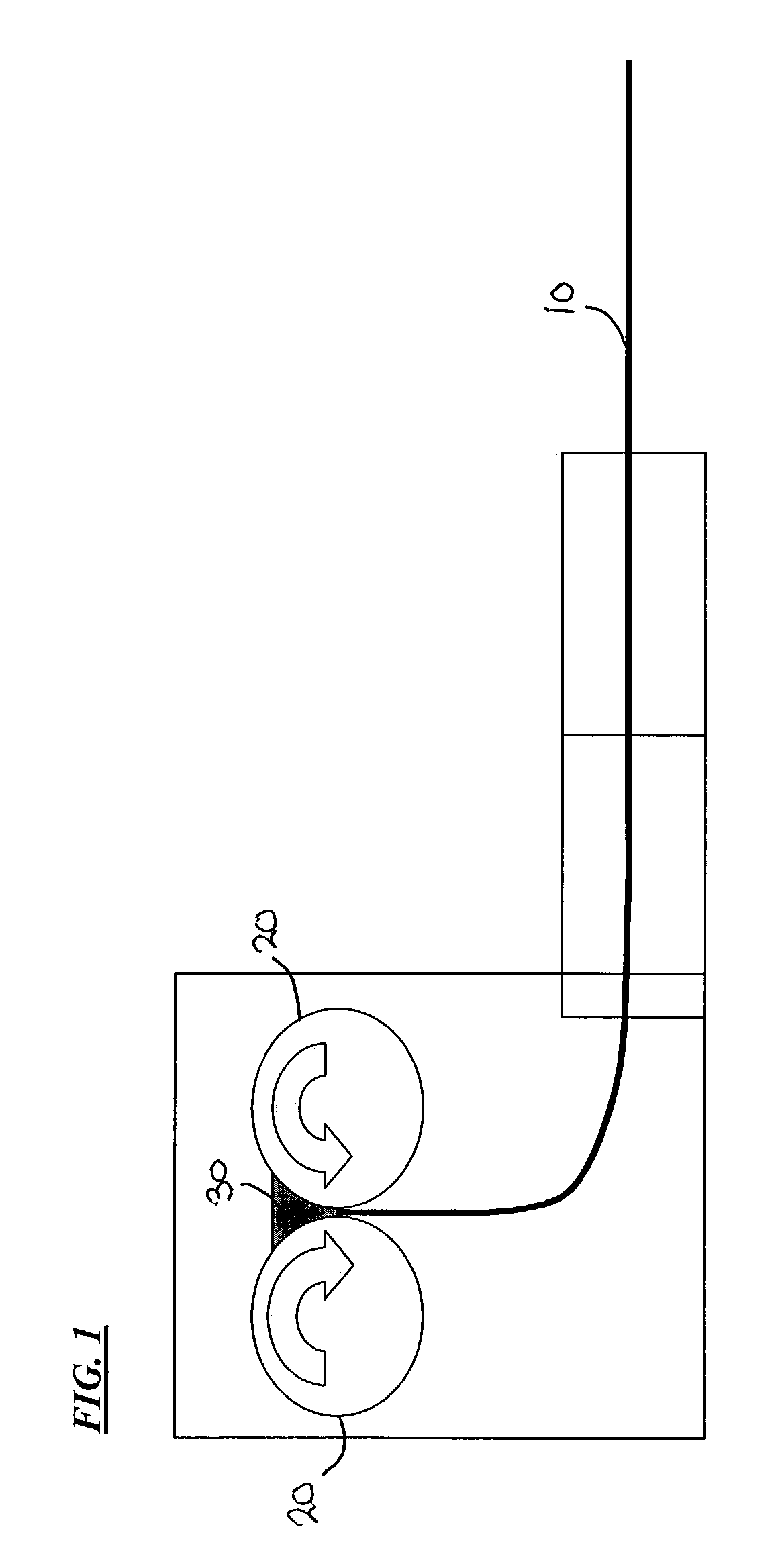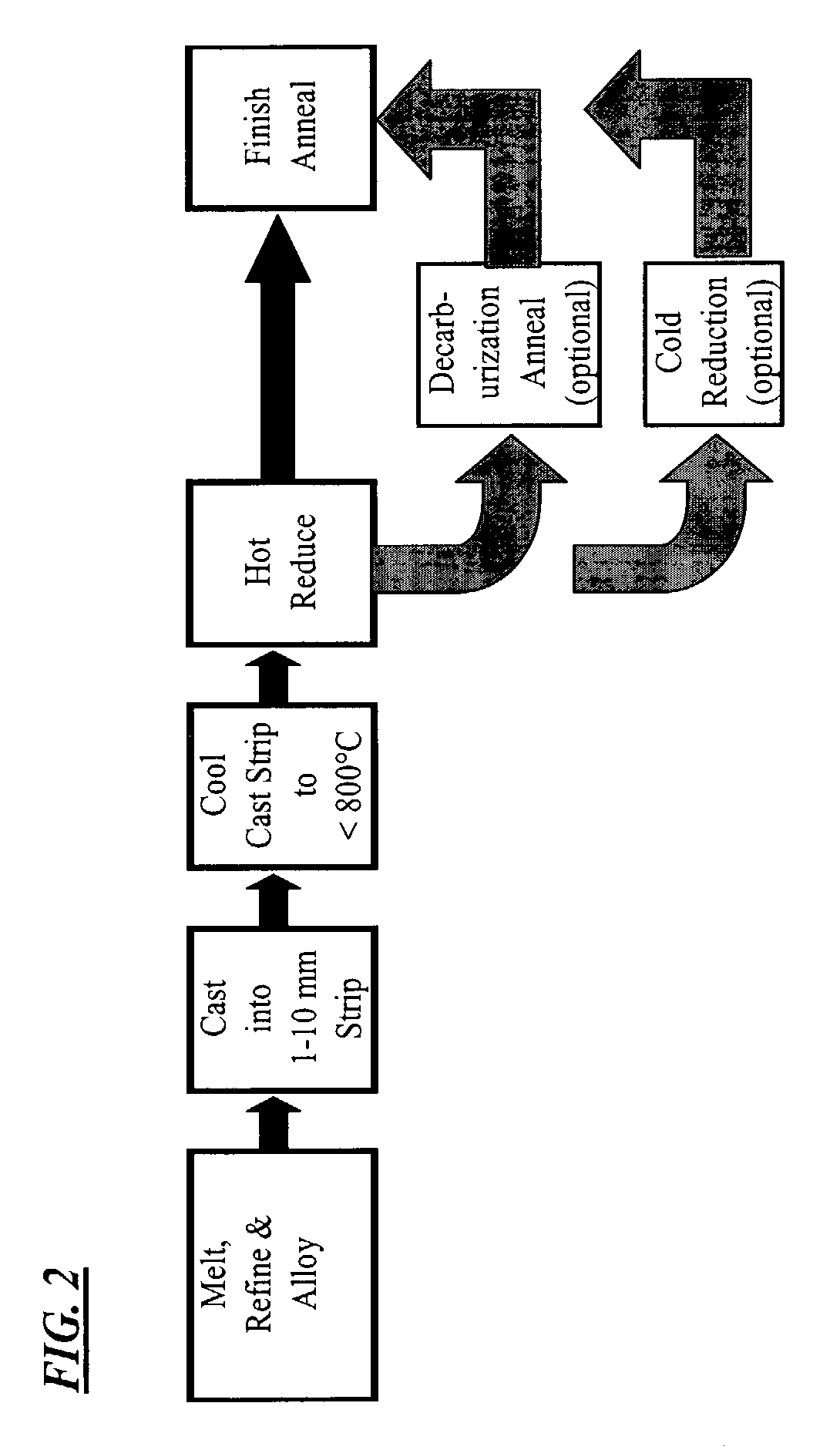Method of continuous casting non-oriented electrical steel strip
a technology of non-oriented electrical steel and continuous casting, which is applied in the direction of magnetic materials, electrical equipment, magnetic bodies, etc., can solve the problems of degrading the magnetic properties, reducing the and reducing the core loss and magnetic permeability of the final produ
- Summary
- Abstract
- Description
- Claims
- Application Information
AI Technical Summary
Benefits of technology
Problems solved by technology
Method used
Image
Examples
example 1
[0105]Heats A and B having the compositions shown in Table I were melted, cast into strips having a thickness of about 0.10 inch (about 2.5 mm) and processed as exemplified in FIG. 2. Cast strips from Melts A having a thickness of about 0.10 inch (about 2.5 mm) and cast strips of Heat B having a thickness of about 0.10 inch (about 2.5 mm), about 0.060 inch (about 1.5 mm) and about 0.045 inch (about 1.15 mm) were provided with a hot reduction of about 30% to about 65% to a thickness of less than 0.040″ (about 1 mm), the hot reduction made in a single rolling pass using about 9.5 inch (about 24 mm) diameter work rolls and a rolling speed of about 32 RPM, from a temperature below T20 as defined in Equation II. The cast and hot rolled strips were descaled, sheared into test samples and final annealed in a batch anneal at about 1550° F. (about 843° C.) for a soak time of about 60 minutes in an atmosphere of 80% nitrogen and 20% hydrogen with a dew point of about 75° F. (about 25° C.), or...
example 2
[0108]Melts A and B of Example 1 were processed in a different embodiment of the method of the present invention whereby the cast strips were processed as exemplified in FIG. 3. As shown in Table I, the composition of Melts A and B provide a volume resistivity (ρ) calculated from Equation I representative of an intermediate-silicon non-oriented electrical steel of the art. The cast and solidified strips were subjected to rapid secondary cooling to a temperature below about 1000° F. (about 540° C.) in accordance with the preferred method of the present invention. The cast, solidified and cooled strips were cold rolled to a thickness of about 0.018 inch (about 0.45 mm). After cold rolling, the strips were finish annealed by batch annealing at a temperature of about 1550° F. (about 843° C.) for a soak time of about 60 minutes in an atmosphere of 80% nitrogen and 20% hydrogen with a dew point of about 75° F. (about 25° C.), or finish annealed as a continuous strip anneal at a temperatur...
example 3
[0111]Melt C shown in Table I was cast into thin strips having a thickness of either about 0.8 inch (about 2.0 mm) or about 0.10 inch (about 2.5 mm) were processed as exemplified in FIG. 4. As Table I shows, the composition of Melt C provided a volume resistivity of about 37 μΩ-cm, making the steel of Melt C representative of an intermediate-silicon non-oriented electrical steel of the art. The cast and solidified strips from Melt C were further subjected to rapid secondary cooling to a temperature below about 1000° F. (about 540° C.) strip in accordance with the preferred method of the present invention. The cast, solidified and cooled strips were reheated to a temperature of 1750° F. (about 950° C.) or about 2100° F. (about 1150° C.) in a non-oxidizing atmosphere prior to hot rolling the cast strip, the hot rolling being conducted in a single pass using about 9.5 inch (about 24 cm) diameter work rolls and a rolling speed of about 32 RPM, from a temperature below T20 wt % γ as defi...
PUM
| Property | Measurement | Unit |
|---|---|---|
| thickness | aaaaa | aaaaa |
| thickness | aaaaa | aaaaa |
| thickness | aaaaa | aaaaa |
Abstract
Description
Claims
Application Information
 Login to View More
Login to View More - R&D
- Intellectual Property
- Life Sciences
- Materials
- Tech Scout
- Unparalleled Data Quality
- Higher Quality Content
- 60% Fewer Hallucinations
Browse by: Latest US Patents, China's latest patents, Technical Efficacy Thesaurus, Application Domain, Technology Topic, Popular Technical Reports.
© 2025 PatSnap. All rights reserved.Legal|Privacy policy|Modern Slavery Act Transparency Statement|Sitemap|About US| Contact US: help@patsnap.com



